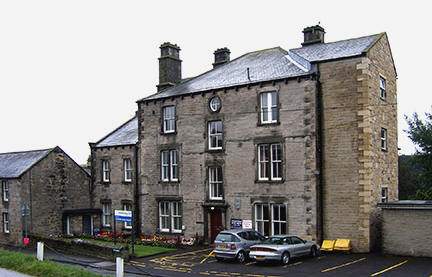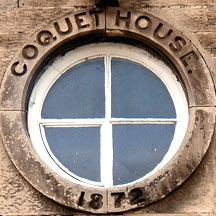Cottage Hospital
Situated at the west end of the village, the Coquetdale Cottage Hospital is the only hospital in west Northumberland between Hexham and Berwick, and was built in 1872 for Excise-man, Joseph Archer.
Joseph was born in Carlisle in 1821, and had settled in Rothbury in the 1850s with his wife, Ann, and family. As well as being an officer with the Inland Revenue, David Dippie Dixon refers to him as the "Village Poet" and notes that he frequently wrote for the Parish Magazine.
Ann died in 1894, and by 1901 Joseph was running the large house as a "lodging house", with his daughter, Elizabeth, as Housekeeper.
In 1905, Joseph sold Coquet House and moved, with three of his elderly children, into "Ashville" about 100m up the road on the opposite side - a house he is understood to have built for his daughters.
It was sold to Miss Catherine Dawson bought Coquet House, who converted it onto a hospital and donated it to the village. She and her sister, Miss Mary Dawson, endowed it with £200 a year.
There were originally three beds,
and all treatment was free.
The sisters were daughters of Ralph Hanson Dawson, "gentleman, wine
merchant", of Wapping, and his wife Margaret Farquhar of
 Rothbury, daughter
and heiress of George Farquhar (who incidentally, gave the ancient fire
engine to Rothbury in 1788).
Rothbury, daughter
and heiress of George Farquhar (who incidentally, gave the ancient fire
engine to Rothbury in 1788).
Margaret Farquhar inherited the estate at Holystone, which eventually descended to her only surviving son William. On his death in 1884 he left everything to his three sisters.
In 1893 Mary Dawson
gave the peal of eight bells to Rothbury Parish Church in memory of William, and
a commemorative plaque can be seen in the church. There are also three
windows in Holystone church in memory of Ralph and Margaret Dawson and "a
much loved sister" who died in 1849. The family coat of arms is among
those carved on the chancel screen at Rothbury. Their final memorial is
the Cottage hospital.
Before her death in 1906, Miss Dawson registered the hospital with the Charity
Commissioners and appointed a local Board of Trustees, who with their successors
administered the growing hospital until the coming of the National
Health Service in 1948.
A maternity unit was founded in 1946 as a memorial
to the Second World War, and after 1948 this expanded rapidly with up to three hundred babies
delivered annually. There was also an expansion
of consultants' clinics and services such a physiotherapy, and in 1956, as a
result of local initiative, the adjoining Hawthorn Cottage was bought as a
hospital extension.
But as medical science advanced and treatment depended more on expensive
technology, concentrated in the larger hospitals, a gradual attrition began.
In 1975 it came under a new Area Health Authority which took over its
administration from the local managers. The maternity unit was
closed, the consultants' clinics was discontinued, and Rothbury was
left to provide only convalescent and geriatric care.
However people's concern
and generosity remained unwavering, and the League of Friends of Coquetdale was
formed in 1978, to provide a focus for local involvement. Over the year's
the Friends have provided many extra amenities, the most striking of which was
the total refurbishing of Hawthorn Cottage for the physiotherapy department in
1990, at a cost of £60,000 raised locally. It was opened in that year by
Jimmy Saville.
In 1993 the hospital became part of the new Cheviot and Wansbeck Trust, whose
financial problems subsequently caused much anxiety. However, the following year plans were laid to build a new Community Hospital in Rothbury.
The old hospital was eventually sold, to be converted into apartments, and in 2007 the new hospital was opened close to the Haugh.
From here continue west towards Rothbury House